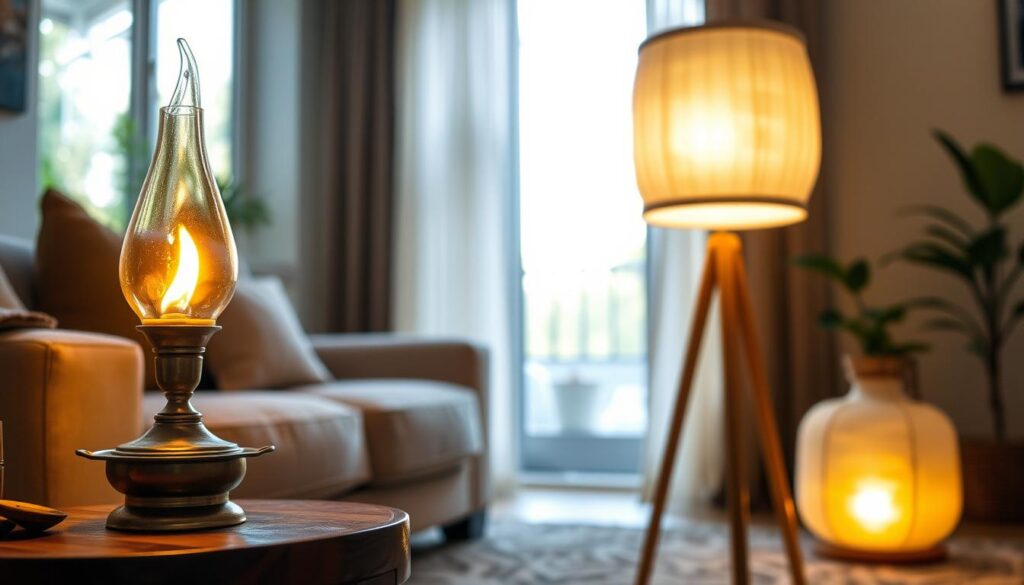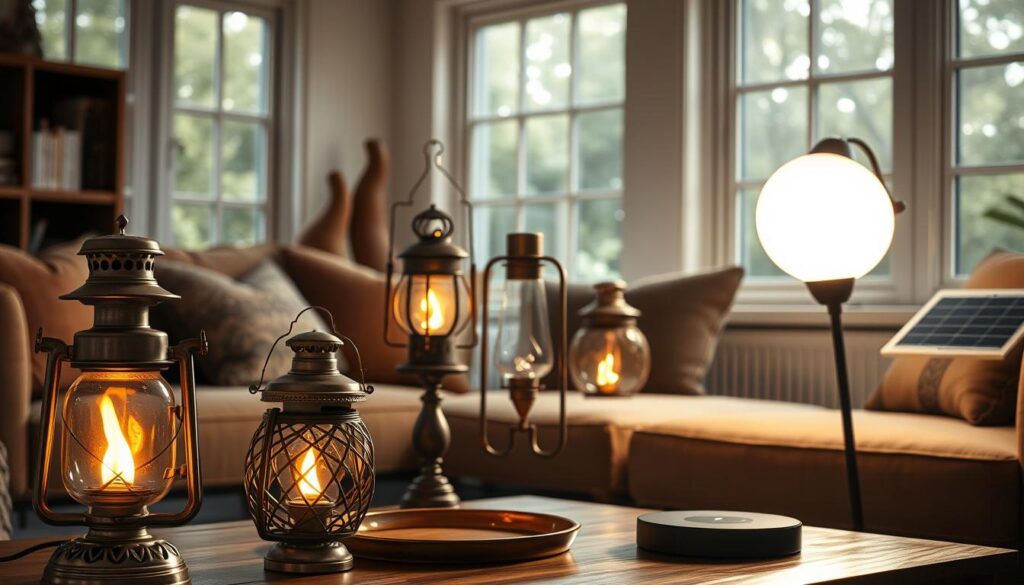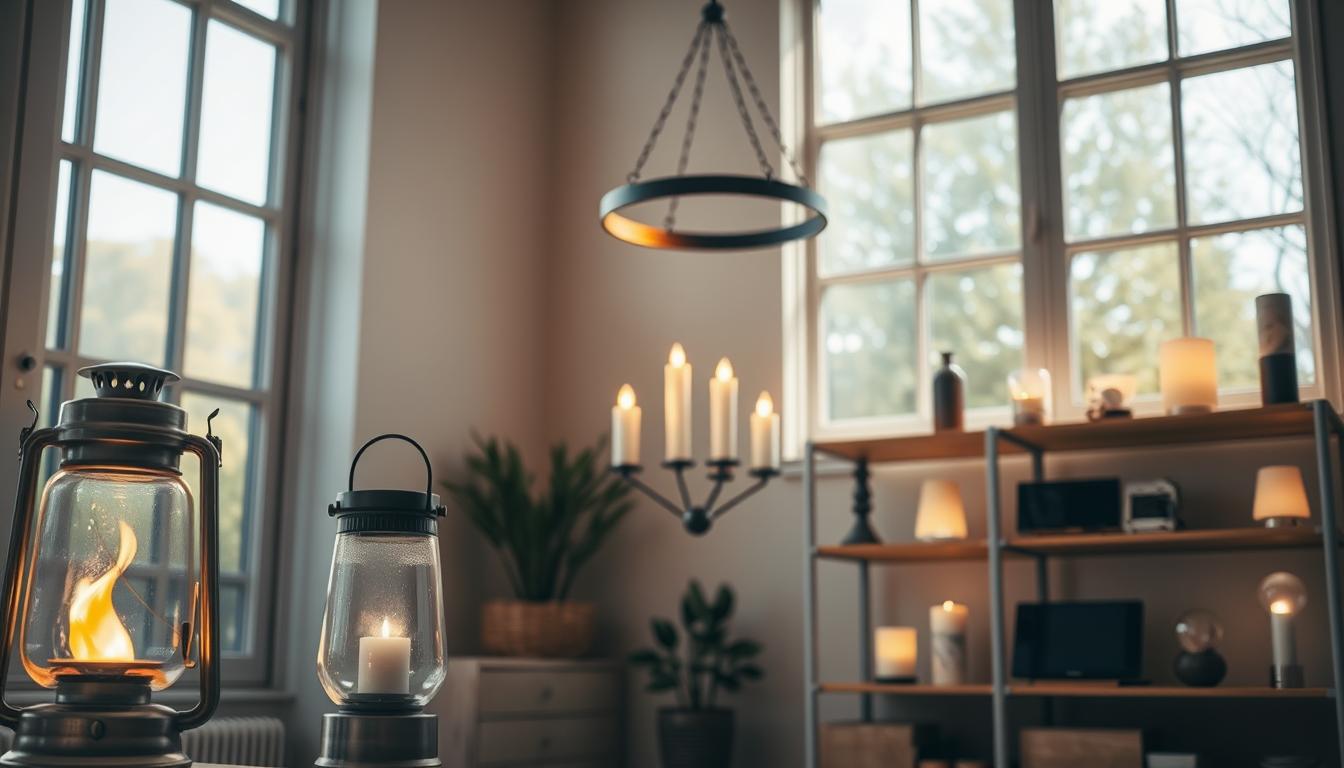More people want to live sustainably, leading to a rise in demand for green lighting. Energy-efficient lamps are a smart choice, offering a unique and eco-friendly way to light up your home. They help cut down on carbon emissions and make your space cozy.

Non-electric lamps, like oil lamps and solar ones, bring many benefits. They are energy-smart and stylish. These lamps can warm up any room, making them perfect for those seeking green lighting options.
Introduction to Non-Electric Lighting
This article dives into the world of non-electric lamps. We’ll talk about their advantages, uses, and upkeep. Whether you’re after a green lighting option or a stylish addition, we’ve got you covered.
Key Takeaways
- Non-electric lamps are a sustainable lighting solution for homes
- Energy-efficient lamps can reduce your carbon footprint
- Oil lamps and solar-powered options are popular choices
- Non-electric lamps can add a touch of warmth and character to any room
- Regular maintenance is necessary to ensure the longevity of non-electric lamps
Understanding Non-Electric Lighting Solutions
For centuries, humans have used non-electric lights like candles and lanterns. As technology grew, so did the variety of non-electric lamps. Today, we have everything from old oil lamps to new solar lights. These options mix beauty, energy savings, and being good for the planet.
Non-electric lights save energy and add charm to any space. They’re great for those who care about the environment. The main perks are:
- Less carbon footprint
- Lower energy bills
- Unique looks and feels
- More safety and dependability
Exploring non-electric lighting opens up many design possibilities. It helps make our homes greener and more sustainable.
Oil Lamps: Traditional Brilliance for Modern Homes
Oil lamps are a classic choice, offering a warm glow. They blend traditional design with modern functionality. This makes them a popular pick for those wanting a sustainable lighting option that uses renewable energy.
Choosing the right oil lamp for your home involves several options. Here are a few:
- Table lamps: perfect for bedside tables or living room coffee tables
- Floor lamps: great for adding ambient light to a room
- Hanging lamps: ideal for kitchens or dining areas
Oil lamps add style to any room and provide reliable light. They’re a good choice for those wanting to cut down on non-renewable energy use. Adding oil lamps to your decor can make your home feel warm and inviting. It also supports a more sustainable lifestyle.
How Does a Lamp That Works Without Electricity Function?
Non-electric lamps are a great alternative to regular lights. They are green lighting options that save money and are good for the planet. These lamps use different fuels like oil, gas, and solar power. This makes them perfect for off-grid lighting needs.
There are a few things to think about with non-electric lamps. These include how they work, the types of fuel they use, and safety features. Here are some important points:
- Basic operating principles: Non-electric lamps turn chemical energy into light. This happens through burning fuel or using solar cells.
- Fuel types and options: You can choose from oil, gas, or solar energy. Each has its own benefits and drawbacks.
- Safety mechanisms: These lamps often have safety features. Things like flame guards and automatic shut-off help prevent accidents.
Learning about non-electric lamps helps you make smart choices for your lighting needs. Whether you’re looking for green lighting or off-grid lighting, you can find the right option for you.
Solar-Powered Lighting Alternatives
Solar-powered lighting is getting more popular. It’s a clean and renewable energy source. These sustainable lighting options are good for the planet and save money on bills.
There are many solar-powered lamps to choose from. You can find solar table lamps, floor lamps, and string lights. These energy-efficient lamps give off bright light and use less energy.
Here are some benefits of using solar-powered lighting alternatives:
- Renewable energy source
- Energy-efficient
- Cost-effective
- Low maintenance
In conclusion, solar-powered lighting is a smart choice. It’s sustainable and energy-efficient. It’s a reliable and affordable way to light up your home and outdoor areas.
Chemical and Battery-Free Luminescence
Exploring alternative lighting solutions, we find the importance of chemical and battery-free luminescence in home design. This approach combines eco-friendly lighting with bioluminescent and chemiluminescent technologies. It uses chemical reactions to offer a sustainable, energy-efficient option compared to traditional lighting.
Chemical and battery-free luminescence helps us use less non-renewable energy. It uses natural processes like bioluminescence for lighting. This makes it both eco-friendly and visually appealing. For example, glow-in-the-dark paints and chemiluminescent lamps can beautify any room while supporting a sustainable lifestyle.
- Energy efficiency: These solutions cut down on non-renewable energy use, appealing to those looking for eco-friendly options.
- Sustainability: They use natural processes for lighting, making them environmentally friendly and visually appealing.
- Innovative design: This technology allows designers to create unique, sustainable lighting that enhances room aesthetics.
As we delve into alternative lighting solutions, chemical and battery-free luminescence is crucial for eco-friendly lighting. Embracing these technologies helps us build a sustainable future. This future is lit by natural processes and eco-friendly lighting solutions.
Choosing the Right Non-Electric Lamp for Your Space
Choosing a non-electric lamp involves several factors. These include room size, lighting needs, and personal style. There’s a wide range of non-electric lamps out there. They offer a green alternative to traditional lights, using renewable energy.
To pick the right one, think about these points:
- Room size: Pick a lamp that lights up the space well.
- Lighting needs: Decide how bright you need the room to be.
- Personal style: Choose a lamp that matches your home’s look.
Popular non-electric lamps include oil lamps, solar-powered ones, and chemical luminescence. Each has its own benefits and downsides. The best choice depends on your needs and taste. By looking at these options, you can find the perfect lamp for your space. It will also help make your home more eco-friendly, using renewable energy.

Maintenance and Care Tips for Non-Electric Lighting
Keeping non-electric lamps in good shape is key. This is true for green lighting and off-grid lighting alike. Regular upkeep can stop common problems and keep your lamps bright.
Here are some easy steps to maintain your non-electric lamps:
- Clean your lamps often to avoid dust and dirt buildup.
- Keep your lamps in a dry, cool spot to avoid damage from moisture or heat.
- Look over your lamps for wear and tear signs. Replace any parts that are damaged or worn out.
By following these tips, you can make your non-electric lamps last longer. They’ll keep giving you green lighting or off-grid lighting for many years. Always be gentle with your lamps and keep them away from harsh chemicals and extreme weather.
With the right care, non-electric lighting can be both useful and eco-friendly. Whether you’re into green lighting or off-grid lighting, regular maintenance is crucial. It ensures your lamps stay bright and reliable for a long time.
Safety Considerations and Best Practices
When it comes to non-electric lighting, safety is key. It’s important to think about potential dangers and how to avoid them. This includes using energy-efficient lamps safely.
Proper ventilation is crucial. It helps prevent toxic fumes from building up. These fumes can be harmful to your health.
Some key safety considerations include:
- Keeping flammable materials away from open flames
- Ensuring that lamps are placed on stable surfaces
- Avoiding overheating, which can lead to fires or explosions
By following these best practices, you can enjoy sustainable lighting safely. As experts in the field say, “safety should always be the top priority when using non-electric lighting.”

Regular maintenance and inspections of your lamps are also important. They help prevent accidents and keep your lamps working well. By being careful with non-electric lighting, you can make your home safer and more sustainable.
Conclusion: Embracing Alternative Lighting Solutions
Non-electric lamps are a great choice for lighting your home. They are eco-friendly lighting and can make any room look better. Plus, they use less energy than regular lights.
These lamps come in many styles, like oil lamps and solar-powered ones. They’re good for the planet and can make your home look unique. You can choose from lights that glow like a flame or ones that use the sun’s power.
When you start looking for new lights, check out the many non-electric options. You’ll find lights that are both stylish and save energy. Choosing these lights makes your home look great and helps the environment too.
FAQ
What is the history of non-electric illumination?
Non-electric lighting has been around for centuries. Early civilizations used candles and lanterns. As technology improved, so did non-electric lamps. Today, we have many options, from oil lamps to solar-powered ones.
What are the benefits of electricity-free lighting?
Non-electric lighting saves energy and adds ambiance. It also looks unique and is eco-friendly. These lamps are a great alternative to traditional lighting.
How do non-electric lamps function?
Non-electric lamps light up without electricity. They use fuel like oil or wax, or renewable energy like solar power. They also have safety features to prevent accidents.
What types of non-electric lighting alternatives are available?
There are many non-electric lighting options. You can choose from oil lamps, solar-powered lamps, bioluminescent solutions, and chemical light sources. Each has its own benefits and suits different needs.
How do I choose the right non-electric lamp for my space?
Think about the size of your room, your lighting needs, and your style. Look at the different non-electric lamps available. Pick the one that matches your needs and style.
How do I properly maintain and care for my non-electric lamps?
Keeping your non-electric lamps in good shape is important. Clean them regularly, store them properly, and fix common problems. Follow the manufacturer’s advice and use best practices to keep your lamps working well.
What safety considerations should I keep in mind when using non-electric lamps?
Safety is key with non-electric lighting. Make sure you have good ventilation and follow fire safety rules. Always use your lamps responsibly to avoid accidents.
